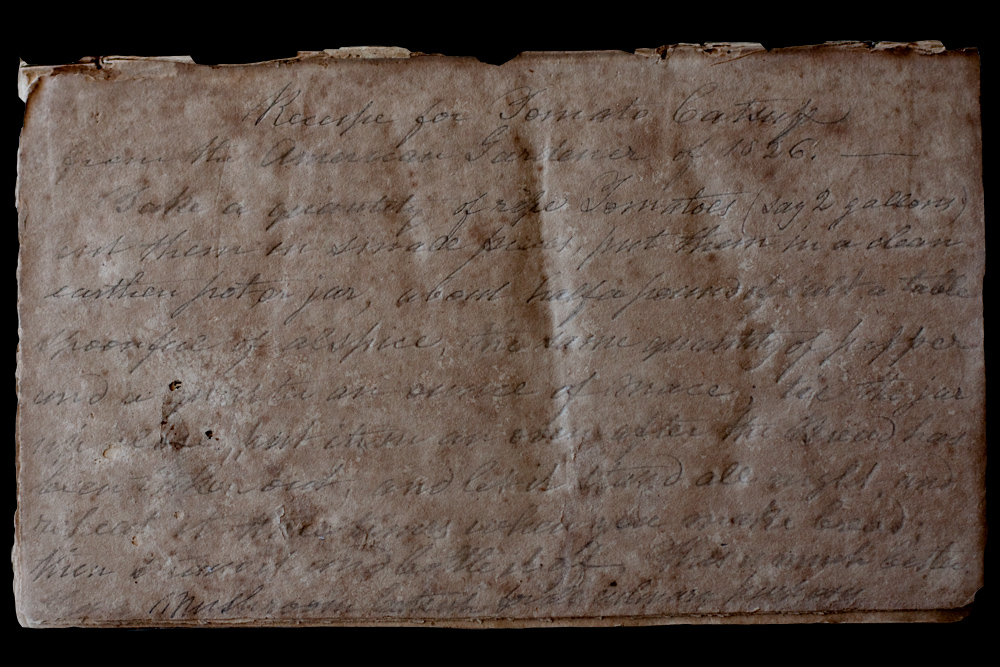Here's a transcript, to the best of my ability to decipher the handwriting:
Recipe for Tomato Catsup
from the American Gardener of 1826. --
Take a quantity of ripe Tomatoes (say 2 gallons)
cut them in small pieces, put them in a clean
earthen pot or jar, about half a pound of salt, a table
spoonful of alspice, the same quantity of pepper
and a quarter an ounce of mace; tie the jar
up close, put it in an oven after the Bread has
been taken out, and let it stand all night, and
reheat it three times when you make bread;
Then strain it and bottle it up. This is much better
than Mushroom Catsup for all culinary purposes.
Donald thought this was interesting-- especially that it was probably jotted down back when tomato ketchup was still something of an innovation-- so he's been telling me I need to blog it. (See? I'm doing it! (g))
After taking the time to carefully wrangle out the words from that sometimes faint handwriting, I thought, "Hey, why don't I google 'catsup' and 'american gardener'?" It was a brilliant idea. Too bad I didn't think of it at the beginning of the blog entry. I could've saved myself a little trouble. Yes, that's right. Look what I found at Google Books:
(You can even read the whole book, if you'd like.)
It's funny to think that this recipe has been sitting in that book for possibly 184 years, waiting for us to find it. How many others may have seen it, along the way? Did the person who jotted it down ever imagine that someone would painstakingly analyze the words in an attempt to read what turned out to be a recipe? If I write a recipe for Santa Fe Stew on the blank pages of my copy of Jane Eyre, will someone find it, someday? ;o)
So then you start to wonder about the person who wrote the recipe. The name inked on the title page-- "Gavin Yuille 1824"-- leads you on another googling mission, and again you strike gold. We purchased the book locally, and (lo and behold) there's information about a man by that name who bought 72 acres of land in this very county (in Daphne), back in 1845. Apparently he was a native of Scotland who moved his family to New York City in 1829, then down through South Carolina (where he may have taught in a school), and finally, in 1834, he ended up in Mobile, where he owned and operated a bakery "at the corner of Dauphin and Jackson Streets" (a spot I can pinpoint on Google Maps). I can trace the basic facts of his life down to when he became a U.S. citizen (April 1838) and when he died (17 September 1849, at the age of 63). (After the bakery burned, he rebuilt it on Government Street, and those acres of land he bought in 1845 were for a large family home and a peach plantation.)
It's pretty amazing what you can find in a few minutes of research, isn't it?
So he probably bought the book while he was still living in Scotland, yet he thought it was worth brining over here. (Or maybe books were so expensive and/or the cost of transporting belongings so cheap that it would've been worth bringing it under any circumstances.)
And get this-- on AbeBooks, there's a manuscript for sale-- "On offer is an original 1820 handwritten account giving details of the start of the Curling Club in Hamilton, Scotland. The title page reads "Annals of Curling" by Gavin Yuille." I don't know how common that name might have been in Scotland at that or any other time, but "our" Gavin Yuille is said to have been born in Hamilton, Lanarkshire (in Scotland), so it's certainly possible.
Anyway-- quite an interesting little expedition from a humble recipe to the history of a person's life!

